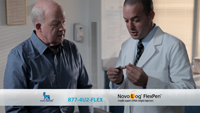When it comes to buying television air time, pharma brands often face steeper entry costs than advertisers in, say, the CPG or automotive sectors. Caveats on a drug’s side effects—typically running 40-45 seconds for some prescription products—can drive up the cost of certain TV media buys pretty quickly. But the advent of new ad-unit lengths is bringing drugmakers much-needed relief.
In the last few years, say media and ad agencies, big pharma’s use of these atypical unit lengths, like the 90-second spot, has steadily increased, bringing much-needed cost savings.
“For several years, we’ve been reliant on the two-minute commercial,” said Josh Martin, SVP, group director of media strategy for Interpublic Group’s ID Media. That’s slowly changing.
In pharma, 120-second ads have dropped in popularity. Meanwhile, the sector’s use of 90-second ads, which require lower media costs than 120s, has continued to rise, from 1% of the industry’s national TV advertising share in 2009, to 5% in 2010, and 12% in 2011, according to figures from Kantar Media. In 2011, the pharma industry bought more than $280 million of 90-second spots on national TV, including English and Spanish broadcast networks, cable networks and national syndication, according to Kantar.
In national cable pharma advertising, where direct-response TV is common, there’s been a “huge spike” in use of 90s, said Martin, who heads up ID Media’s Johnson & Johnson business.
The relatively new 90-second unit length represents a “happy medium” between 60s and 120s, Martin added. That is, they’re long enough to squeeze in the familiar “talk to your doctor” call-to-action messaging, as well as required drug disclosures and stipulations.
As such, 90s satisfy both sides of the equation, while allowing advertisers to save money. Shorter air/broadcast time can result in up to 25% in media savings, Martin said. That’s money that can be reinvested to extend the life of a campaign.
To be sure, pharma advertisers are still using unit lengths of 30, 60 and 120 seconds. One-minute commercials, in fact, continue to dominate, attracting 50% of pharma advertiser spending in 2011, but that’s down from a 75% share in 2009, Kantar data show. These are often adequate for non-branded products, for example, or products or brands that don’t require a significant number of disclosures.
Advertisers across a variety of categories—auto, insurance, retail and entertainment—have likewise embraced the use of 90s. In March, Dick’s Sporting Goods ushered in a new campaign with a 90-second ad. Chrysler, likewise, launched a 90-second ad for its new Dart compact sedan during this year’s MLB All-Star Game opening.
Drugmakers, in particular, seem to be driving the trend, using 90-second ad units for branded promotion, as in the case of Novo Nordisk’s FlexPen insulin delivery device, and for non-branded disease awareness advertising, like a Bristol-Myers Squibb/Sanofi effort around peripheral artery disease. Both commercials aired in 2010.
Given pharma’s fair-balance requirements, this isn’t surprising, said Ned Russell, managing director of Publicis’ Saatchi & Saatchi Wellness, a New York-based consumer advertising agency. “No body else wants to buy 90 seconds worth of time,” he said. “You do it because you have to.”
Anything in an ad can be made shorter, except for the fair balance. Russell said he has clients using 90s as well as 75s. They’re cheaper than 120s. “Everyone’s doing more with less, so if you can wind up cutting 30 seconds off, and do it within 90 vs. 120, good on you. If you can do it within 75, even better.”
Among other reasons behind the rise of 90s, the increasing availability of 15-second unit lengths has propelled their use, said ID Media’s Martin. “A rise in the pool of 15s has made it easier for networks to add spots together and get more reach…They now have the ability to create commercial pods in different lengths a lot easier than before.”
Shorter unit lengths allow networks more flexibility to piece together different unit lengths within a specified commercial pod. For instance, if a commercial pod is two minutes long, a network can piece together a 90-second spot and two 15s, or one 90 and one 30.
Networks, said Saatchi’s Russell, may be realizing that they have to be more flexible to capture pharma ad dollars. “They don’t want to make their medium unaffordable, but there are the regulatory realities that that group of clients needs to operate within.”
As a general rule, the longer the unit length, the greater the likelihood of higher consumer response, said Martin. So 60s outperform 30s, and 120s outperform 90s. In the case of pharma, the 90-second spot, in many cases, is still a better fit.
Shorter than a two-minute ad, 90-second ads can lower the cost of entry for pharma. However, there’s one challenge the drug industry continues to wrestle with, even with the shorter ad units.
“More time is more pressure,” said Saatchi’s Russell. “120 [seconds] is longer, but 90 is still very long, and it should speak to the need for pharma marketers to be engaging and relevant because if you’re not, your viewers will zone out before you get to the fair balance. You are a click away from oblivion.”








